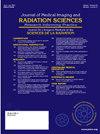CALM (Catch And Light-up Marker)
IF 2
Q3 RADIOLOGY, NUCLEAR MEDICINE & MEDICAL IMAGING
Journal of Medical Imaging and Radiation Sciences
Pub Date : 2025-07-01
DOI:10.1016/j.jmir.2025.102048
引用次数: 0
Abstract
Aim
This study aims to assist radiographers in accurately placing anatomical markers during radiographic procedures by leveraging computer vision and AI technologies. The system seeks to reduce human error and enhance workflow efficiency, which is essential for ensuring precise diagnosis and treatment.
Methods
CALM integrates AI-driven models with automated monitoring tools, including scanners and cameras, to capture data from laboratory instruments and visual observations. It uses real-time screen monitoring via an HDMI splitter to detect X-ray orders, extract “R” or “L”, and display the corresponding marker on an LED screen next to the X-ray machine.
Results
In the initial 10 tests, when X-ray orders were captured from the screen, CALM successfully identified the right and left sides and correctly displayed “R” or “L” on the LED screen with 100% accuracy. However, when the orders were captured from paper forms, the accuracy dropped to 90%, likely due to OCR limitations in extracting the correct side information from the printed text.
Conclusion
In conclusion, CALM has proven to be useful in accurately identifying and displaying the correct side (right or left) in X-ray orders captured from the screen, achieving 100% accuracy. However, this study is limited to orders that specifically contain the words “right” and “left.” For orders with other terminology, different approaches will need to be further investigated and developed to ensure consistent and accurate marker placement.
CALM(捕捉和点亮标记)
目的本研究旨在利用计算机视觉和人工智能技术,帮助放射技师在放射照相过程中准确定位解剖标记。该系统旨在减少人为错误,提高工作流程效率,这对于确保精确诊断和治疗至关重要。scalm将人工智能驱动的模型与自动监控工具(包括扫描仪和摄像头)集成在一起,从实验室仪器和视觉观察中捕获数据。它通过HDMI分配器使用实时屏幕监控来检测x射线顺序,提取“R”或“L”,并在x光机旁边的LED屏幕上显示相应的标记。结果在最初的10次测试中,当从屏幕上捕获x射线顺序时,CALM成功地识别了左右两侧,并以100%的准确率在LED屏幕上正确显示“R”或“L”。然而,当从纸质表单中捕获订单时,准确性下降到90%,可能是由于OCR在从打印文本中提取正确的侧信息方面的限制。综上所述,CALM已被证明在从屏幕上捕获的x射线序列中准确识别和显示正确的一侧(右或左)是有用的,准确率达到100%。然而,这项研究仅限于包含“右”和“左”这两个词的订单。对于使用其他术语的订单,需要进一步研究和开发不同的方法,以确保一致和准确的标记放置。
本文章由计算机程序翻译,如有差异,请以英文原文为准。
求助全文
约1分钟内获得全文
求助全文
来源期刊

Journal of Medical Imaging and Radiation Sciences
RADIOLOGY, NUCLEAR MEDICINE & MEDICAL IMAGING-
CiteScore
2.30
自引率
11.10%
发文量
231
审稿时长
53 days
期刊介绍:
Journal of Medical Imaging and Radiation Sciences is the official peer-reviewed journal of the Canadian Association of Medical Radiation Technologists. This journal is published four times a year and is circulated to approximately 11,000 medical radiation technologists, libraries and radiology departments throughout Canada, the United States and overseas. The Journal publishes articles on recent research, new technology and techniques, professional practices, technologists viewpoints as well as relevant book reviews.
 求助内容:
求助内容: 应助结果提醒方式:
应助结果提醒方式:


